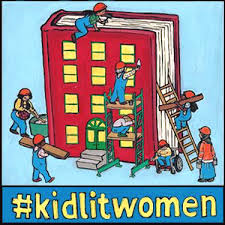It’s been an EXHAUSTING month in the children’s lit field – really, in the literary industry in general. Between the current administration wanting to gut federal support for libraries, to the continued firestorm of authors naming industry insiders and other high profile movers and shakers as serial abusers, it’s been… hard to focus on actually writing. That’s been par for the course for the last year, of course, but lately it’s become harder to imagine this industry in two years, or five years time. With all of the turmoil finished, who will we be then? (Or, will we ever finish?)
It’s Women’s History Month, and across the internet, children’s lit folk have committed to 31 days of posts focused on “improving the climate for social and gender equality in the children’s and teens’ industry.” Children’s lit people have an open invitation to join in the conversation in various places, using the Twitter hashtag #kidlitwomen or to access all the #KidlitWomen posts this month on the FaceBook page https://www.facebook.com/kidlitwomen/
While I haven’t participated, I’ve quietly been reading industry professionals’ essays (and ironic poems) about the issues of being overlooked and undervalued, and how to address those issues. Through these writings, we observe where power and representation in terms of who receives professional acclaim, and who does not receive it, intersect. Edi Campbell has continued to do her good work in interpreting data to come up with a rough outline of the facts on diversity within the larger picture (which you’ll find here and more here.) As usual, she is spot-on, and timely.
I am collecting these links here as a place for me to come back to them – because I think they will, in time, be proof — that we’ve been talking about some of these inequities for ages. The numbers won’t lie when it comes to looking back and seeing if a change has been made. The revelatory Ripped Bodice Diversity Report for 2017 dropped in a PERFECTLY timed space with its message of “we have to do better, and we’re doing worse than last year.” Honestly, it’s hard to see where “better” is going to come from, when right now a lot of powerbrokers within the industry seem content with virtue signaling to make sure everyone knows they’re “committed” to being better… but these claims will have to be seen to be believed. Women struggle as a whole within the writing industry, and in the children’s lit world, it continues to be woman-heavy in staffing, but sustain a culture which awards and prioritizes men, as if the business savvy act of writing for children and teens – the largest industry IN publishing just now – is equal to giving birth and nurturing an infant to childhood with one’s own body. Not to mention how women of color are left with not even the few perquisites offered to women in the industry as a whole. And let’s not talk about disabled women, or queer women, or older women, or…
How do we move from desire to action? How do we get ourselves out of conversation and across the room to… act?
If we were writing this scene in a novel, what would happen next?
